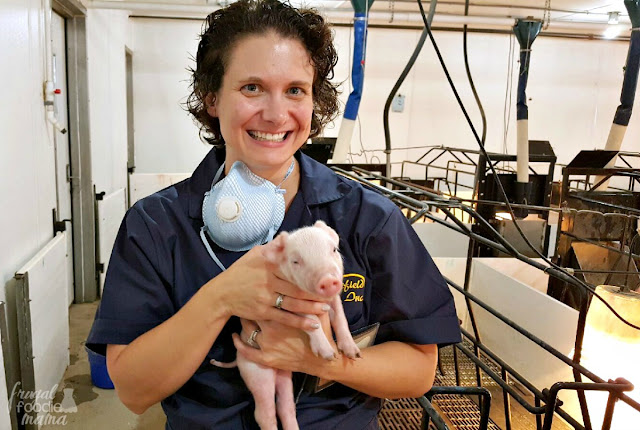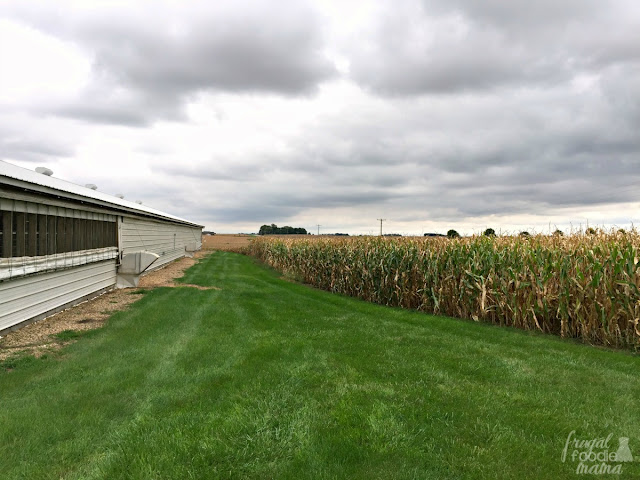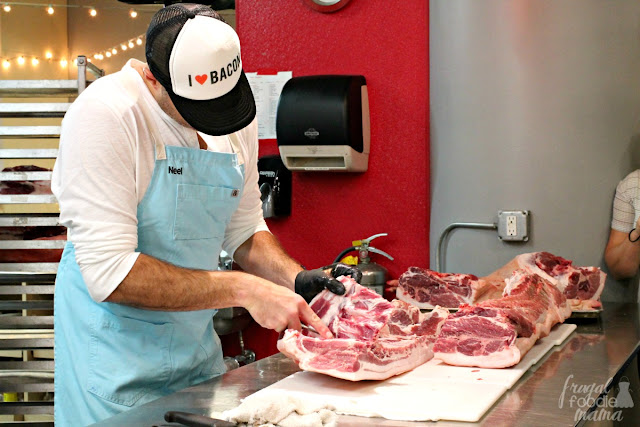From the farm to your dinner table, here is a peek into what goes into real pig farming in the United States...
A big thank you to the National Pork Board, the National Pork Producers Council, & the Minnesota Pork Board for hosting me for Pass the Pork 2016. As always, all opinions & thoughts expressed below are 100% my own.
I have to admit that sometimes being a food & travel blogger is a pretty cool gig to have. Every so often I get an invite to travel to a different state, eat some amazing food, learn a little about a city or certain area of food production, and all while getting to hang out with a fabulous group of fellow bloggers. A couple of weeks ago I had the opportunity to travel to Minneapolis as part of the Pass the Pork blogger tour with the National Pork Board. While I am no stranger to buying, cooking up, & enjoying pork (have you guys seen all my recipes using bacon yet?? ;) ), I didn't know much about the actual production side of the pork industry, aka pig farming. I have always been one who has jumped at the chance to see firsthand just exactly where my food comes from, so I was excited that a visit to an actual Minnesota pig farm was on the trip's agenda.
The folks at Wakefield Pork graciously extended a full tour of their pig farming facility to the bloggers attending the Pass the Pork tour, and no question was off limits. I was really impressed with how transparent and gracious they were in explaining everything that goes into their pig farming process from breeding to market...
This baby piglet was less than a day old!
The Langhorst family at Wakefield Pork takes great care and pride in how their pigs are raised. Everything that is done on the farm is done for the benefit & comfort of the sows because let's face it- the sows are literally what bring home the bacon for the pig farmers. To ensure that nothing harmful gets to their pigs or leaves with you, everyone who visits Wakefield Pork has to go through what they call showering in & showering out. And it is exactly what it sounds like, folks. You take a shower before entering & then change into all new clothes (no make-up or hair products allowed- can you tell? ;) ). Then you go through the same process when leaving. This process allows the farmers to keep disease and sickness down thus producing more healthy pigs. And healthy pigs means more good quality pork products for you and I.
At Wakefield Pork, they breed, care for the sows, allow the sows to farrow (give birth), and then the piglets are kept with the sows for 18-19 days after birth. At that point, the piglets are transferred to a nursery until they are about 2 months old.
Photo Credit: National Pork Board
When the piglets are around 2 months old and 50 pounds, they are sent to local finishing barns that are contracted through Wakefield Pork. The pigs remain at the finishing barns until they are about 6 months old and reach a whopping weight of 270-290 pounds! Once they reach their target weight, they are sent to market and then for harvesting to be purchased by nationally known brands such as Hormel & Johnsonville. (Yes, folks. This is how you get bacon, and pork chops, and pulled pork, and ribs, and pork belly, and all the other pork deliciousness we all love, okay? ;) )
Though I learned so much about pig farming during our day at Wakefield Pork, I was most surprised to learn about just how sustainable & eco-friendly pig farming is. The manure from the pig farm and finishing barns is collected and then used on the cornfields of the pig farmers that work with Wakefield. Wakefield actually uses technology to analyze each farmer's fields and its soils so that they receive just the right amount of the fertilizer. This helps reduce unnecessary run-off of fertilizer into streams and water sources because only what the soil needs is used. The corn that is grown in these fields is actually used in the feed for the pigs. In fact, corn makes up to 60% of the feed that is given to the pigs. The pigs eat that feed, their manure is collected and used for fertilizer, and the whole cycle starts all over again. Because of these newer, more sustainable practices, pig farming has managed to reduce its water use by 40%, its land use by 80%, and in turn its carbon footprint is 35% smaller than it was in 1959.
After our tour of their pig farm, the Langhorst family showed us some true Minnesota hospitality and invited us back to their home for a lunch of smoked ribs and ham. And yep, they used that beast below to smoke the ribs. ;)
On our last day of the Pass the Pork tour, we headed to the Kitchen in the Market in downtown Minneapolis to witness the fabrication of a half pig by Neel Sahni, the Manager of Foodservice Marketing & Innovation for the National Pork Board. To actually see how the cuts of pork are broken down and cut was a pretty cool experience. (CLICK HERE to see a short video of part of the fabrication process.)
Just a few tidbits and tips that I learned during the fabrication process that I want to pass along to you all...
- The National Pork Board is currently working with the USDA to rename pork chops to the reflect the cuts of beef that most of us are already familiar with. So soon you will see pork chops in your local supermarket labeled as Ribeye chops, Sirloin roasts & chops, Porterhouse chops, and so on.
- When selecting pork chops at your local grocery store, redder is better. Check the color of the meat away from fluorescent lights, if possible. Also look for chops that spring back when you gently push on them.
- When buying other cuts like pork loins and roasts, pay attention to whether or not a solution of water, salt, and/or sugar has been added. If a solution has been added, the package must be labeled with that. It is a good idea to brine any cuts of pork that do not have a solution added, especially pork loins since they have less fat.
Photo Credit: National Pork Board
After the fabrication demonstration, we broke off into four different cooking teams to prepare the cuts of pork that we just watched get freshly butchered. I had the pleasure of preparing two different dishes with Mary Langhorst (co-owner of Wakefield Pork), Charlie Torgerson (executive chef and pit master of Charlie T's Foods), and the lovely Kellie Hemmerly of the blog, The Suburban Soapbox. I took the helm for the preparing our Bahn Mi Burgers while Kellie headed up most of the prep for our Jamaican Jerk dish. :)
Once all the cooking was done and the final touches were added to each dish, it was time for the best part- getting to try all of the different dishes that we had made!
So I just may be totally biased here, but these little Bahn Mi Burgers my team whipped up were my favorite dish of the day. ;) In fact, they provided the inspiration for a tasty pork recipe that I will be sharing with you all on the blog next week, so be looking for it!
I couldn't have asked for a better experience learning about pig farming in Minnesota. From the breeding process all the way to the tasty dishes on our plates, we touched on just about every aspect of the pork industry in the United States. And I hope that I was able to pass along a little of that knowledge and insight on to you all in today's post. :)
Want to learn even more about real pig farming in the Minnesota as well as the United States? Then be sure to pop over and explore the National Pork Board, the National Pork Producers Council, & the Minnesota Pork Board sites!
Be sure to check Danae from Recipe Runner's recap post of the Pass the Pork tour as well...
If you loved this post, you might also like my...
Want to follow along with all my foodie travel adventures?
Then be sure to follow me on Instagram! :)
CLICK HERE to see which fun parties I am sharing this post at.
CLICK HERE to see which fun parties I am sharing this post at.
















